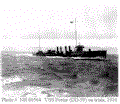Click On Image
For Full Size Image |
Size |
Image Description |
Contributed
By And/Or Copyright |
Namesakes
|
 |
63k | Photo #: 80-G-K-17588. Captain David Porter, U.S.N. (1780-1843) portrait in oils, possibly by John Trumbull. Photographed September 1954 by PHC A.L. Brooks. This portrait is in the collections of the U.S. Naval Academy Museum, Annapolis, Maryland. Official U.S. Navy Photograph, now in the collections of the U.S. National Archives.
David Porter was born at Boston, Massachusetts, on 1 February 1780. He entered the U.S. Navy as a midshipman in 1798 and served in the Quasi-War with France and the Barbary Wars. He became a prisoner-of-war when USS Philadelphia was captured off Tripoli in October 1803. Following his release in 1805, Porter commanded USS Enterprise and later was in charge of naval forces at New Orleans, Louisiana. During the War of 1812, Captain Porter was Commanding Officer of the frigate Essex during her wide-ranging assault on British shipping, a campaign that continued until Essex was overwhelmed by HMS Phoebe and Cherub at Valpariso, Chile, on 28 March 1814. Following the War, Porter was a member of the Board of Navy Commissioners and led an expedition to supress West Indies piracy in 1823-25. He resigned his commission in 1826 and spent three years as commander-in- chief of the Mexican navy. Porter died on 3 March 1843 while serving as U.S. Minister to Turkey. | Bill Gonyo |
 |
78k | Admiral David Dixon Porter, USN, (1813-1891) was born at Chester, Pennsylvania, on 8 June 1813, the son of Commodore David Porter (1780-1843). His naval career began as a midshipman in 1829, and included service in the peacetime cruising Navy, the Mexican War and the U.S. Civil War. The latter conflict saw him rapidly rise from the rank of Lieutenant to Rear Admiral. In 1862, he was in charge of the Mortar Flotilla during the campaign to capture New Orleans and the lower Mississippi River. He took command of the Mississippi Squadron in October 1862 and led it through the active phase of the Western Rivers campaigns. Rear Admiral Porter spent the last several months of the Civil War in command of the North Atlantic Blockading Squadron. Following the War, Porter was promoted to Vice Admiral in 1866 and served as Superintendant of the Naval Academy. He became the Navy's senior officer, with the rank of Admiral in 1870, and remained an influential figure in naval affairs until his death on 13 February 1891. | Bill Gonyo |
USS Porter (DD-59)
|
 |
92k | USS Porter (Destroyer No. 59) photographed while making 29 knots on trials, headed south at 2:22 PM, 08 March 1916. U.S. Naval Historical Center Photograph. | Fred Weiss |
 |
129k | Undated photo of destroyers showing (nearest to farthest), USS Warrington (Destroyer No. 30), USS Walke (Destroyer No. 34) and USS Porter (Destroyer No. 59) moored at Queenstown, Ireland during WWI service. Source: Imperial War Museum Ministry of Information First World War Collection, Photo No. © IWM (Q 18176). | Mike Green |
 |
86k | Arriving at Queenstown, Ireland, on 04 May 1917, as part of the first U.S. Navy force to reach European waters for World War I service. Courtesy of James C. Russell. U.S. Naval Historical Center Photograph. | Joe Radigan |

0505906 |
103k | USS Porter (Destroyer No. 59) at sea during World War One, probably in European waters. Note her camouflage scheme and hull number worn under her pilothouse. | Dave Wright |
 Porter (CG-7) Porter (CG-7)
|
 |
119k | USCGC Porter (CG-7) photographed circa 1924-30, while operating to support the enforcement of Prohibition laws as a unit of the U.S. Coast Guard. She was originally USS Porter (DD-59). Note what appears to be a large radio direction finder amidships. Courtesy of the Commandant of the Coast Guard, 1930. U.S. Naval Historical Center Photograph. | Fred Weiss |
 |
41k | On Coast Guard service during the Prohibition Era, from the Official Coast Guard Website. | Mike Green |
 |
180k | Porter (CG-7) at Boston Navy Yard, 03 February 1929. Leslie Jones Collection, Boston Public Library. | Ed Zajkowski |

